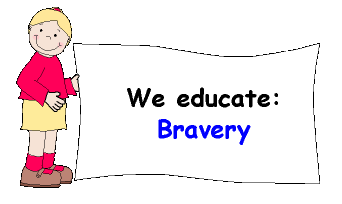|
Bravery is defined as a quality of those people who act with courage, effort, vigour, strength, daring and boldness. The actions and heroic feats that history records have been done by brave people; nevertheless to be a brave person it is not necessary to do a feat or heroic action but to demonstrate a brave attitude towards the facts of our daily life that require so. Bravery is a quality that can be educated from a very early age in life, through all the activities that the child does daily at home and in the early childhood centre. The more appropriate thing to do is to refer to concrete examples to show the child the attitude of brave people, so that they know how they acted and to develop in the children, admiration, respect and affection for these people. The examples to be shown can be: martyrs and heroes of their mother country who have carried out heroic battles, or personalities from other countries or from their own community, of recognized bravery, of characters of stories and cartoons, of people who have risky professions and trades or who practice risk sports, etc. |
ACTIVITY
No 1 |
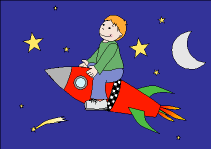 |
Summary of the activity: Solomon the puppet comes to class and reads a story to the children; in the second part of the activity the puppet will start a conversation on bravery, and finally the children will form and compare sets of stars and moons. Objectives:
Procedures:
Material Resources: The Solomon puppet, pictures or photos of: a astronaut, a spaceship, a astronaut floating, the moon, the cosmos, and four stars, four moons and four astronauts for each child (figures printed on fine cardboard and cut out).
Development of the activity: _ How are you? _ I am glad that you are well, now you are going to be far better with the activity that we are going to make. _ Do you remember me? well, for those who do not remember me: I am the wisest of the wise people, for that reason they call me Solomon. Today I am going to tell you something that you are going to like very much, it is about a child.........
Did
you like the story?
2nd Part Brave people are those that act with courage in difficult situations; they are not scared and act with decision and bravery. To travel to the cosmos is a feat, and astronauts are very brave people (show the picture or photo of a astronaut) because they risk their lives going up to the cosmos, that is a very, but very distant place, some of them have also gone to the moon (show a picture of the cosmos, and another one of the moon). In order to travel to space, the astronauts must wear special suits. They must take oxygen, water and food in the spaceship (show a picture or photo of a spaceship), because in the places where they will go there is no water, nor food, nor oxygen to breathe. It is a very, but very dangerous trip. They must go through a hard training to be able to live in the spaceship because when the rocket leaves our planet, the astronauts begin to float like a feather in the air. (show a picture or photo of a astronaut floating in the air). Remember what Yuri’s mother told him "there are many risks to travel to the cosmos, for that reason to be a astronaut you have to be very brave", but it is a very interesting, beautiful and very useful trip for the entire world, because thanks to the astronauts’ bravery and their feats, today we know the cosmos, the moon and in the future the planets. Solomon
will ask the children:
3rd Part He hands out to each child 12 pictures that are the four astronauts, the four moons and the four stars, all together and mixed up. He
instructs the children to form three sets: one of the moons, another
one of the stars and another one of the astronauts, and once formed
the sets he will ask them: To close the activity, the educator will remind the children what Yuri’s mother said about the astronauts, and he will use the sets of astronauts to make imaginary trips to dangerous places in space. |
CRITERIAL
ASSESSMENT |
|||
Observed
conduct |
YES |
NO |
Comments |
They
answered correctly the questions on the astronauts’ bravery. |
|||
They
knew to say why they think that the astronauts are brave. |
|||
They
used the sets to relate them to the astronauts’ courage. |
|||
ACTIVITY
No 2 |
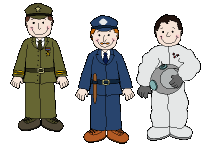 |
Summary of the activity: We will talk about the people who distinguish themselves or are distinguished for their heroic feats, or by actions of recognized bravery, and finally the children will be asked about the topic. Objectives: To develop in the children feelings of admiration and respect towards certain people who distinguish or are distinguished for their bravery. Procedures:
Material Resources: Pictures or photos of the characters that we are going to talk about.
Development of the activity: We are going to give several examples, the educator will choose those that are suitable for an activity, and later he can continue with other characters in the following activities. Examples:
Men who practice high risk sports for which a lot of courage is needed, such as mountain climbers and navigators, etc. High risk professions such as firemen, pilots’, sailors’, etc. Researchers, for example, of space, like the astronauts, divers who have to go deep down into caves, anthropologists who study very old civilizations, etc. The educator will display pictures or photos of these people; he will speak to the children about what they do, of their courage and daring to do their tasks. Characters from stories, cartoons, or literary works, known for their daring and courage, for example, The Quijote, The Cid.
2nd Part After
showing all the pictures, the educator will ask the children: |
CRITERIAL
ASSESSMENT |
|||
Observed
conduct |
YES |
NO |
Comments |
They
expressed admiration and respect when speaking about brave people. |
|||
They
knew how to describe the actions and feats that characterize brave people.
|
|||
They
identified themselves with some of them. |
|||
ACTIVITY
No 3 |
 |
Summary of the activity: The educator will lead the children in a group poem that they will learn to form a literary group that will be called "The group of the brave ones" and the parents will be invited. In the first part of the activity the children will learn the poems, in the second part the children who are going to recite and to participate in the choir will be selected. The third part consists of the performance, and it will end with a summary of the activity led by the educator. Objectives: Procedures:
Material Resources: Fireman, sailor, and explorer suits and a basket with sweets.
Development of the activity:
2nd Part The group will be set, for which we suggest that the educator teaches these children to recite with proper diction, suitable emphasis and intonation; as well as with emotion and gestures that each verse requires. The poem "I want to be" can be recited by two children dressed as sailors, each one says one verse. The poem "I will be" can be interpreted by a choir of 6 to 7children, giving a chance to children who have not recited yet and it will be done in the following way: In the first verse: The choir of 7 children says: When I grow up I want to work A child dressed as a sailor says: on a boat through the wide sea. In the second verse: The first child says: And you, my friend, what would you like to be? The second child says:- Me, to be very brave to be able to work. A third child dressed as a fireman says: Like a fireman A fourth one dressed as an explorer says: and to climb a mountain. The complete choir finalizes saying: We will all be brave!
3rd Part |
CRITERIAL
ASSESSMENT |
|||
Observed
conduct |
YES |
NO |
Comments |
They
managed to do the recitation with the necessary intonation, diction,
and gestures. |
|||
They
showed positive emotions and feelings (satisfaction, joy, rejoicing,
pleasure, etc.) during the recitation. |
|||
They
managed to coordinate their verbal actions in the spoken choir. |
|||
They
have made positive exclamations in a spontaneous way about courage. |
|||
ACTIVITY
No 4 |
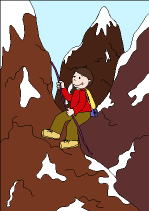 |
Summary of the activity: This is a motion game. In the first part of the activity the educator explains to the children the game "The Mountain climbers", in the second part the children will play the game, and finally the winners will be rewarded. Objectives: To develop in the children experiences about actions that require decision, effort, and vigour as qualities of a brave person. Procedures: Material Resources: A beam or a rope, and little flags.
Development of the activity: He explains to the children that the game consists of reaching a little flag that will be at the end of a rope or a vertical beam and that they must climb like the mountain climbers to reach it. The little flags will be at the end of a beam or rope of 2 meters of height at the most, hooked in a way that the children can take it easily. If a rope is used we have to bear in mind that it must have knots at every 20 cm. and it will be tight; from the first knot to the ground there will be a height between15 to 20cm approximately. In any case, the educator will have to count on the help of other adults to watch carefully and to help the children during this game to avoid any possible risk. The rules of the game are: The winner will be all the children who manage to reach one of the little flags and bring it down (the little flag will be small and it will give the possibility of lowering it without occupying the child’s hands so that he can carry it in a pocket or in his clothes.
2nd Part The ascent will be done in turns and the rest of the children will be encouraging the one who climbs and will cheer the one who manages to reach the little flag and lowers it.
3rd Part He will remind the children of the bravery of the mountain climbers and that they will also be able to climb mountains in the future. |
CRITERIAL
ASSESSMENT |
|||
Observed
conduct |
YES |
NO |
Comments |
They
managed to climb in an independent way. |
|||
They
climbed with help. |
|||
They
felt satisfaction with the activity, giving samples of daring. |
|||
They
made reference to the bravery of the mountain climbers and their own. |
|||
ACTIVITY
No 5 |
Summary of the activity: The educator will give to the children an group picture of the characters already known by them in the previous activities, and he will ask them to choose the character that they want to describe. Objectives: That the children make simple descriptions of the characters already known by them, directing the description towards bravery as a quality that distinguishes them. Procedures:
Material Resources: Pictures or photos of the characters who are going to be described.
Development of the activity: He will tell them what the activity consists of: "Now you must say everything, everything that you know about these characters, first you are going to select a picture, and later you will say what you know about him or her. Remember that they are all very brave people."
2nd Part
3rd Part |
CRITERIAL
ASSESSMENT |
|||
Observed
conduct |
YES |
NO |
Comments |
They
managed to make a simple description of the character’s bravery. |
|||
They
needed help to describe what it was asked of them. |
|||
They
occasionally identified themselves with some of the characters. |
|||
ACTIVITY
No 6 |
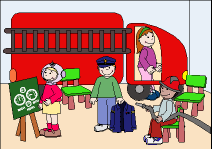 |
Summary of the activity: This is a role play on the topic "The brave ones". The activity begins with an initial conversation of the educator with the children, in the second part they will play the roles that they have selected and finally the children will be asked questions. Objectives: To develop in the children experiences about a group of activities by very brave people. Procedures: Game. Material
Resources: Toys and materials to organize the following
play corners:
Development of the activity:
2nd Part If the children select other roles such as the surfer or the mountain climber, etc., the educator will try to offer them the necessary toys and materials, if he does not have them he can suggest to those children imaginary actions and diverse objects that serve as substitutes and with which they can also perform the actions of the role.
3rd Part |
CRITERIAL
ASSESSMENT |
|||
Observed
conduct |
YES |
NO |
Comments |
They
adequately carried out the fundamental actions of the role in an independent
way and displaying courage. |
|||
They
needed help to perform the role. |
|||
They
knew how to explain why they chose that character based on his bravery.
|
|||
They
identified themselves with the brave character represented in the
role. |
|||
They
showed behaviours that can be evaluated as brave people. |
|||


